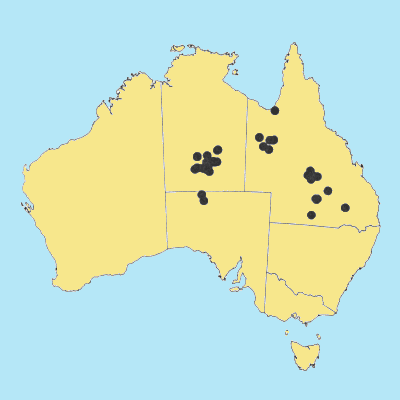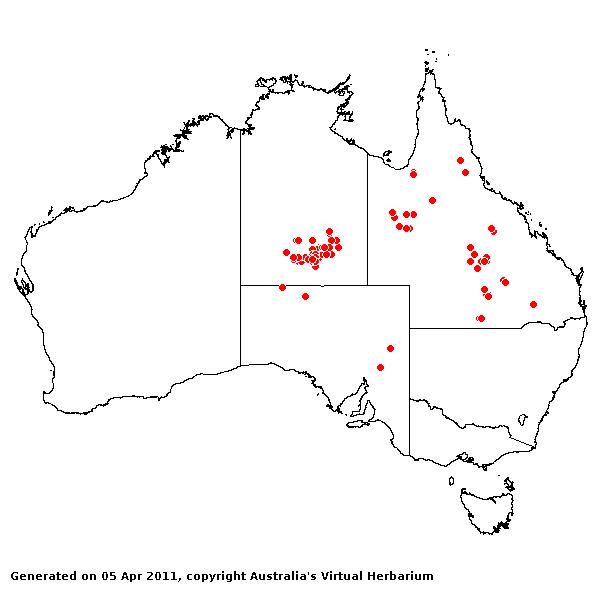Aristida biglandulosa J.M.Black. Trans.&
Proc. Roy. Soc. S.A. 57: 146, t.8, fig 9 (1933).
Classification. (GPWG 2001) : Subfamily Aristidoideae. Aristideae.
Type of Basionym or
Protologue Information: LT: R. Tate s.n., Jun 1894, Australia:
Northern Territory: Central Australia: Glen Hellen (AD). LT designated by
Simon, Austr. Syst. Bot. 5: 177 (1992).
Recent synonyms:
A. biglandulosa var. laevis B.K.Simon.
Key references
(books and floras): [1981] M.Lazarides in J.Jessop (ed)., Flora of
Central Australia (449), [2002] D.Sharp & B.K.Simon, AusGrass,
Grasses of Australia, [2006] J.Jessop, G.R.M.Dashorst, F.M.James, Grasses
of South Australia (321).
Illustrations:
[1983] J.C.Tothill & J.B.Hacker, Grasses of Southern Queensland
(106(37)), [2005] K.Mallet (ed.), Flora of Australia 44B: Poaceae 3
(Fig. 16D-E), [2006] J.Jessop, G.R.M.Dashorst, F.M.James, Grasses of South
Australia (321, fig. 252).
Derivation: L.
bis, twice; glans, acorn; -ula, diminutive; -osa,
possession. There are two swellings at the pedicel bases.
Habit.
Perennial. Culms stature robust to moderate, 60–120 cm tall, 3–4 -noded.
Mid-culm internodes glabrous. Lateral branches branched. Leaf-sheaths smooth or
antrorsely scabrous, glabrous on surface. Ligule a fringe of hairs, 0.5 mm
long. Leaf-blades straight, flat or conduplicate or involute or convolute,
15–30 cm long, 3–5 mm wide. Leaf-blade surface scabrous.
Inflorescence.
Inflorescence compound, a panicle. Panicle linear, 20–30 cm long, 2–3 cm wide.
Spikelets.
Spikelets pedicelled. Fertile spikelets 1-flowered, comprising 1 fertile
floret(s), without rachilla extension, lanceolate, terete, 10–16 mm long.
Glumes.
Glumes similar, thinner than fertile lemma. Lower glume lanceolate, membranous,
keeled, 1-keeled, 5 -nerved. Lower glume surface glabrous. Lower glume apex
mucronate. Upper glume lanceolate, 10–16 mm long, membranous, keeled, 1-keeled,
1–3 -nerved. Upper glume surface glabrous. Upper glume apex mucronate.
Florets.
Fertile lemma 11–12 mm long, without keel, 3 -nerved. Lemma apex awned, 3
-awned. Median (principal) awn without a column. Lateral lemma awns present.
Palea without keels. Anthers 3. Grain 7–8 mm long.
Continental
Distribution: Australasia.
Australian
Distribution: Northern Territory, South Australia, Queensland.
Northern Territory:
Central Australia North, Central Australia South. South Australia:
North-western, Lake Eyre, Flinders Ranges. Queensland: Burke, Gregory
North, Maranoa, Mitchell, Warrego, Cook, South Kennedy.
Notes.
A. biglandulosa differs from A. pruinosa by having glumes ± equal
in length and from A. calycina var. praealta by having a lemma more
than 10 mm long. It was originally thought that there were two varieties with
smooth and tuberculate lemma furrows as in A. calycina, A. benthamii
and A. jerichoensis but on close examination there appear to be some
tubercles always present, although sometimes difficult to see.
Arid areas of the
Northern Territory, South Australia and Queensland. Loams, alluvial soils and
"desert" country of central Queensland. Flowering and fruiting
December to October.



